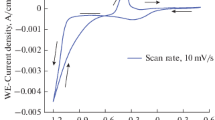Abstract
The method of ferromagnetic resonance (FMR) was used to study magnetic properties of thin films of half-metallic ferromagnetic Heusler alloys Co2Cr0.6Fe0.4Al and Co2MnSi depending on the film thickness and the presence or absence of a vanadium buffer layer. It is shown that the FMR method is a highly efficient technique for studying nanoscale magnetic properties of thin films, especially for the investigation of their magnetic inhomogeneities and anisotropy. Samples of Co2Cr0.6Fe0.4Al and Co2MnSi were prepared by magnetron-sputtering deposition on substrates of single-crystal silicon dioxide (SiO2) with an orientation (100). It has been shown that the magnetic properties of thin Co2Cr0.6Fe0.4Al films strongly depend on both the film thickness (25 or 100 nm) and the presence of an intermediate vanadium layer (50 nm). Well-resolved spin-wave modes were observed in the sample 100 nm thick without a vanadium buffer layer, which made it possible to determine the parameter of spin stiffness D for this ferromagnet. Two series of thin films of Co2MnSi have also been studied, which were prepared on a buffer layer of vanadium (42 nm thick): (1) with various thicknesses (4–100 nm) and a fixed annealing temperature (450°C) and (2) with a fixed thickness (80 nm) and various annealing temperatures (425–550°C). It has been shown that in the series of Co2MnSi films with a variable thickness (4–100 nm) the greatest value of magnetization is reached for a film with a thickness of 61 nm. The investigations of the other series of films, which were annealed at various temperatures, show that to achieve both a greater magnetization and a better structural homogeneity, annealing at temperatures T ≥ 450°C is required. In addition, low-intensity spin-waves were observed in some samples with thicknesses of 100 and 61 nm, which made it possible to estimate the spin-stiffness parameter D for the Co2MnSi Heusler alloy as well.
Similar content being viewed by others
References
S. A. Wolf, D. D. Awschalom, R. A. Buhrman, et al., “Spintronics: A Spin-Based Electronics Vision for the Future,” Science 294, 1488–1495 (2001).
A. Gupta and J. Z. Sun, “Spin-Polarized Transport and Magnetoresistance in Magnetic Oxides,” J. Magn. Magn. Mater 200, 24–43 (1999).
S. Picozzi, A. Continenza, and A. Freeman, “Role of Structural Defects on the Half-Metallic Character of Co2MnGe and Co2MnSi Heusler Alloys,” Phys. Rev. B: Condens. Matter Mater. Phys. 69, 094423 (2004).
S. Kämmerer, A. Thomas, A. Hütten, and G. Reiss, “Co2MnSi Heusler Alloy As Magnetic Electrodes in Magnetic Tunnel Junctions,” Appl. Phys. Lett. 85(1), 79–81 (2004).
J. Schmalhorst, S. Kämmerer, M. Sacher, et al., “Interface Structure and Magnetism of Magnetic Tunnel Junctions with a Co2MnSi Electrode,” Phys. Rev. B: Condens. Matter Mater. Phys. 70, 024426 (2004).
B. Z. Rameev, R. Yilgin, B. Aktas, et al., “FMR Studies of CrO2 Epitaxial Thin Films,” Microelectron. Eng. 69, 336–340 (2003).
B. Z. Rameev, A. Gupta, A. Anguelouch, et al., “Probing Magnetic Anisotropies in Half-Metallic CrO2 Epitaxial Films by FMR,” J. Magn. Magn. Mater 272–276, Part 2, 1167–1168 (2004).
B. Z. Rameev, A. Gupta, G. X. Miao, et al., “FMR Study of Strain-Induced Magnetic Anisotropies in CrO2 Thin Films,” Phys. Status Solidi A 201(15), 3350–3353 (2004).
B. Z. Rameev, A. Gupta, G. Miao, et al., “The Magnetic Anisotropy of Thin Epitaxial CrO2 Films Studied by Ferromagnetic Resonance,” Tech. Phys. Lett. 31(9), 802–805 (2005).
V. Z. Rameev, A. Gurta, F. Yildiz, et al., “Strain-Induced Magnetic Anisotropies in Epitaxial SrO2 Thin Films Probed by FMR Technique,” J. Magn. Magn. Mater. 300, e526–e529 (2006).
S. Kämmerer, S. Heitmann, D. Meyners, et al., “Room-Temperature Preparation and Magnetic Behavior of Co2MnSi Thin Films,” J. Appl. Phys. 93(10), 7945–7947 (2003).
Ch. Kittel, Introduction to Solid State Physics (Wiley, New York, 1996).
P. E. Wigen, “Microwave Properties of Magnetic Garnet Thin Films,” Thin Solid Films 114(1–2), 135–186 (1984).
A. Maksymowicz, “Spin-Wave Spectra of Insulating Films: Comparison of Exact Calculations and a Single-Wave-Vector Model,” Phys. Rev. B: Condens. Matter 33(9), 6045–6053 (1986).
A. M. Portis, “Low-Lying Spin Wave Modes in Ferromagnetic Films,” Appl. Phys. Lett. 2(4), 69–71 (1963).
L. Ritchie, G. Xiao, Y. Ji, et al., “Magnetic, Structural, and Transport Properties of the Heusler Alloys Co2MnSi and NiMnSb,” Phys. Rev. B: Condens. Matter Mater. Phys. 68, 104430 (2003).
Author information
Authors and Affiliations
Additional information
Original Russian Text © B.Z. Rameev, F. Yilidiz, S. Kazan, B. Aktaś, D. Rata, D. Bürgler, P. Grünberg, K.M. Schneider, S. Kämmerer, G. Reiss, A. Hütten, 2006, published in Fizika Metallov i Metallovedenie, 2006, Vol. 102, No. 4, pp. 383–391.
Rights and permissions
About this article
Cite this article
Rameev, B.Z., Yildiz, F., Kazan, S. et al. FMR study of thin films of Co2Cr0.6Fe0.4Al and Co2MnSi Heusler alloys. Phys. Metals Metallogr. 102, 357–365 (2006). https://doi.org/10.1134/S0031918X06100036
Received:
Issue Date:
DOI: https://doi.org/10.1134/S0031918X06100036




